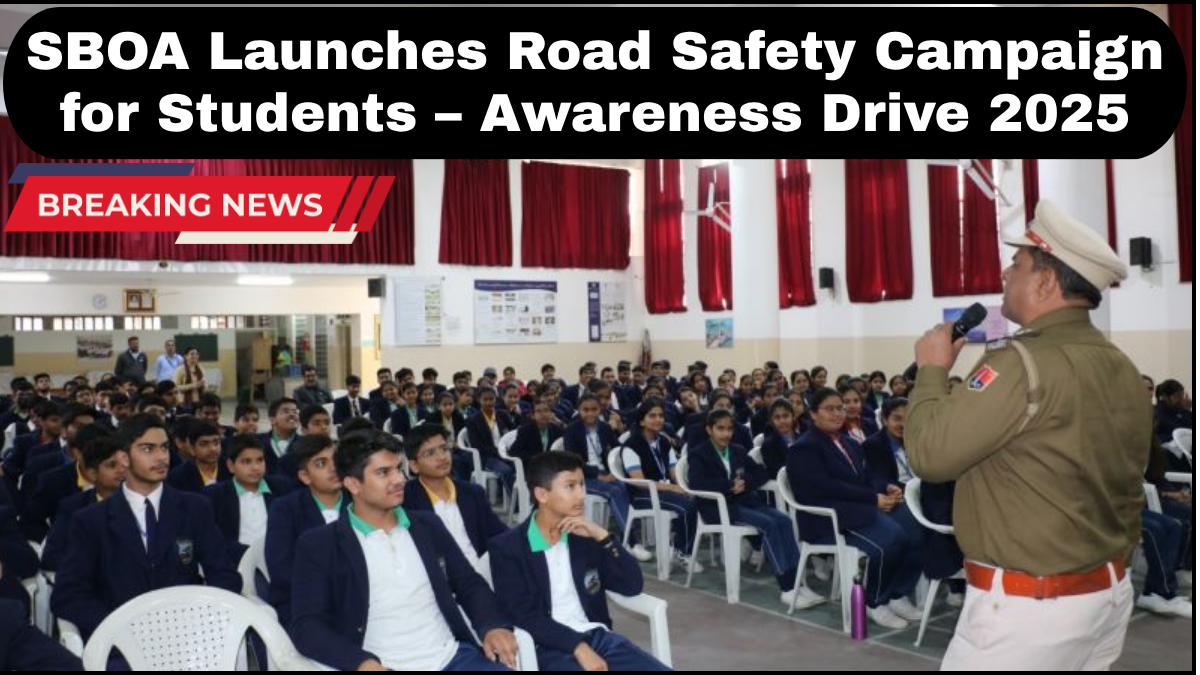In a decisive move to foster responsible behavior among young commuters, the SBOA Educational Trust has launched the Road Safety Education Drive 2025, targeting school and college students. This year’s initiative, titled Awareness Drive 2025, aims to instill critical knowledge and skills related to traffic norms, personal safety, and civic responsibility in students from an early age.

A Timely Intervention for Safer Roads
India records some of the highest numbers of road accidents annually, many involving young pedestrians or two-wheeler riders. Recognizing this alarming trend, SBOA has taken a proactive stance by rolling out a comprehensive campaign across its network of institutions. This road safety education drive is not just about warning signs or speed limits—it’s about building a mindset of awareness, accountability, and long-term behavioral change among youth.
Campaign Highlights and Objectives
The Awareness Drive 2025 is designed to go beyond standard lectures and posters. It’s a full-fledged educational program that includes:
-
Interactive Seminars and Workshops: Led by traffic police officers, healthcare professionals, and road safety experts, these sessions address real-world scenarios, accident statistics, and life-saving practices.
-
Simulation-Based Training: Students experience driving simulators that replicate road conditions, helping them understand the consequences of distracted driving, speeding, and rule violations.
-
Peer-to-Peer Learning Initiatives: Older students are trained as Road Safety Ambassadors, empowering them to mentor their peers and lead community-based awareness drives.
-
On-Campus Road Safety Zones: Designated areas within school premises replicate streets with signboards, pedestrian crossings, and signals to offer practical exposure to traffic rules.
Building Traffic Awareness for Students
Teaching traffic awareness for students is no longer optional—it’s a necessity. Young people often underestimate the risks associated with everyday commuting, especially when using bicycles or motorcycles. SBOA’s program is specifically tailored to address the risks that affect this demographic:
-
Helmet Use and Seatbelt Compliance: Emphasis is placed on consistent use of safety gear and the legal implications of non-compliance.
-
Distracted Commuting: Students are educated on the dangers of using mobile phones while walking or cycling on busy roads.
-
Understanding Road Signs: The campaign reinforces the meaning and significance of traffic signs and how to respond to them in real-life situations.
-
Emergency Response Skills: Basic first-aid training and knowledge on how to act during an accident are incorporated into the curriculum.
Community Engagement and Parent Involvement
SBOA understands that sustainable impact comes from engaging all stakeholders. The 2025 road safety education drive also brings parents into the conversation. Special sessions are organized to encourage them to model safe behaviors, such as not using phones while driving or obeying traffic signals. When families echo the same values at home, the message becomes much stronger for students.
Integration with Academic Learning
To make road safety an intrinsic part of student life, SBOA has partnered with local education boards to integrate elements of traffic awareness into the school curriculum. Assignments, quizzes, poster-making contests, and storytelling competitions are themed around road safety to foster creative engagement.
Measuring Impact
To ensure effectiveness, the campaign includes pre- and post-assessment modules that gauge student awareness and behavioral change. Feedback loops involving students, teachers, and parents will help refine the initiative annually, making it more relevant and impactful.
Frequently Asked Questions (FAQ)
Q1: What is the primary goal of the SBOA Road Safety Education Drive 2025?
A: The main objective is to promote road safety awareness among students and instill responsible commuting habits through interactive learning, community engagement, and practical training.
Q2: Who can participate in the Awareness Drive 2025?
A: The campaign is open to all students of SBOA institutions, ranging from primary to senior secondary levels. Select events and sessions also involve parents and faculty members.
Q3: How does this drive teach traffic awareness for students?
A: Through workshops, simulations, quizzes, and real-life demonstrations, students are taught the importance of traffic rules, personal safety, and proactive behavior on roads.
Q4: Are there any follow-up actions after the campaign?
A: Yes. Post-campaign surveys, feedback, and ongoing safety clubs will help maintain the momentum and continue spreading road safety awareness throughout the academic year.
Q5: Can this model be adopted by other schools?
A: Absolutely. SBOA encourages other institutions to adopt similar strategies and is open to sharing resources and best practices developed during the Awareness Drive 2025.
click here to learn more